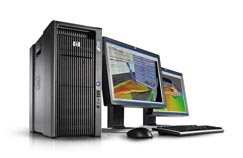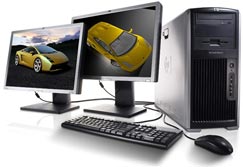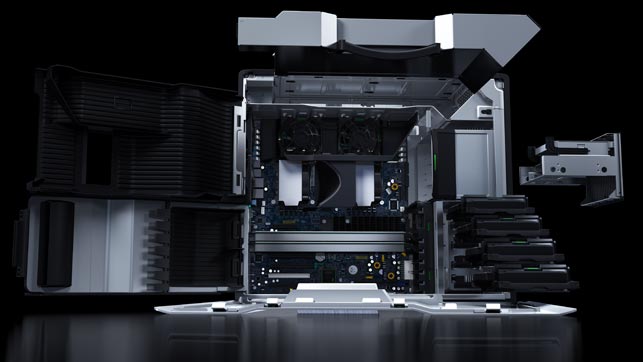HP’s new workstation family, the Z Series is something to get quite excited about. This is not just because it features Intel’s powerful new Xeon 5500 series processors, but because HP has completely re-thought the workstation and the way it can be serviced, upgraded and generally taken to bits.
To my mind, only Apple and Sun have delivered similar levels of serviceability to those offered in HP’s new Z series, which is completely tool-less in design. This was demonstrated at the launch event of the new workstations, where HP showed just how easy they were to service and maintain, starting with the flagship Z800.
The whole system relies on clearly marked green levers and clips to give users visual clues as to how to take things apart. HP has done this before but never to this level of simplicity. First of all there are no wires inside the machine! These are all routed behind the back of the motherboard — not only to make things easier, but not to interfere with the Computational Fluid Dynamics (CFD) — optimised airflow throughout the machine. Even the dongles used to power high-end graphics cards, such as the Quadro FX 5800, are routed behind the motherboard and neatly clipped away when not in use.

Forget screwdrivers, the Z800 can be taken apart in minutes, with your bare hands
Everything in the system, from graphics cards to hard drives (and even motherboard), feature innovative mechanisms for easy and tool-less removal. Components that rely on direct electricity, such as the power supply and memory fans, use blind mate connectors, which are funnel-shaped to guide the components into place.
The power supply itself has been completely redesigned, and runs the whole length of the chassis so it can take in cool air from the front of the machine and as a result generate less fan noise. User maintenance and diagnosis has also been improved and should the workstation develop a power problem the supply unit can be removed simply by pulling it out by its handle. Then plugging it into the mains will help the user verify the cause of the problem. If the supply is indeed faulty the green light on the side of the unit will not come on. HP will then ship out a replacement power supply which can be easily installed by the user.
In its quest for even quieter machines HP has also innovated in its cooling mechanisms. Specially designed injection moulded ducting means each CPU in a dual socket machine receives fresh air from the front of the workstation reducing the load and improving acoustics. Dedicated fans for each memory bank also run independently from each other to minimise noise.
For those craving even fewer decibels, a liquid cooling option will be available soon and new Intel solid state hard drives, which not only run quieter than traditional physical drives, but consume less power and produce less heat, will also be introduced. These will also increase performance when accessing a lot of data, frequently.
THE Z Family
HP’s new Z workstation series feature three models, the Z800, Z600 and Z400. The entire family is based around Intel’s new Xeon processor 5500 and 3500 series (codenamed Nehalem), which feature integrated memory controllers and Turbo Boost Technology.
The Z400 is a single socket machine taking the price/performance position in the range (though HP will continue to produce its Core 2 Duo-based xw4600 for an even lower entry point). The Z600 is a compact dual socket workstation, but for ultimate expandability the Z800 offers up to 192GB RAM and 7.5TB of storage.
What makes HP stand out from the crowd is its innovative approach to chassis design, which looks set to make the servicing of workstations an absolute breeze
All workstations are armed with 1,333MHz DDR-3 memory and new professional graphics solutions have been introduced across the line. These include Nvidia’s Quadro FX380, FX580, FX1800, and FX3800, which join the established FX4800, and FX5800 in the high-end machines. The choice of AMD graphics cards has also been expanded over previous generation workstation families with the ATI FirePro V3700, V5700 and V7750 all offered as standard options.
Power saving
HP has made some bold statements about power, claiming that on average its new workstations consume 35 percent less power than similarly configured machines in its previous generation. In terms of power efficiency, all of its power supplies now surpass the 80plus initiative and are now 85 percent efficient. The redesigned 1,100W unit in the Z800 is even 89 percent efficient.
HP has also done a lot of work on power saving and a new hibernate mode called HP WattSaver reduces power consumption to 0.8W, compared to the 2.1W in its previous generation workstations.
Industrial Design
HP engaged BMW DesignWorks as part of its industrial design team and to do the global customer research into what its customers want from workstations. In addition to the totally tool-less design to transform the way users re-configure systems, the Z600 and Z800 feature integrated handles making it easier to move them around on site. Also, because the workstations don’t have rubber feet, they can be slid around on carpets and tiled floors.
Styling was also high on the agenda and the ‘design language’ developed by DesignWorks expresses clean lines and premium materials. The grille that runs down the entire front of the Z600 and Z800 was made possible by incorporating a slot loading optical drive and brushed aluminium side panels also feature. Finally, with its injection moulded components, the machine also looks elegant from the inside, as opposed to the usual mess of wires and clips.
Conclusion
With the introduction of the new Xeon 5500 Series, it’s an exciting time for workstations in general. This is because performance is about to go through the roof, particularly when users are multitasking or running multithreaded applications like 3ds Max.
However, while this level of performance will be seen across new product introductions from all the major workstation vendors, what makes HP stand out from the crowd at this moment in time is its innovative approach to chassis design, which looks set to make the servicing of workstations an absolute breeze. We’ll be putting the new models through their paces in the coming months, so stay tuned. Meanwhile turn to page 45 for our first impressions of the Xeon 5500 Series.
HIGH-SPEED WINDOWS and LINUX on THE SAME MACHINE? No Problem
Despite being one of the most interesting technologies to appear at HP’s workstation event, it was surprising that this new workstation virtualisation technology was given so little stage time. Parallels Workstation Extreme enables users to run multiple Operating Systems on a single workstation, meaning Linux and Windows users don’t have to work with two workstations concurrently or resort to dual boot. But the real beauty of the technology is that it is claimed to run applications at 95-100% of their full speed.
Parallels, the developer of the Operating System virtualisation software technology which makes this possible, told DEVELOP3D that it has already had a lot of interest from the automotive and aerospace sectors. As a company, Parallels is best known for its software that enables Windows to run at speed on Apple’s OS X. The new workstation-class product will do a similar thing for Windows and Linux so engineers could switch between their Linux-based CAE software and Windows-based design software, accessing the same data off the hard drive array, whilst driving efficiency and reducing the costs and power requirements of maintaining two workstations concurrently.

Schlumberger, a specialist in the oil and gas sector, showcased Parallels Workstation Extreme running on a HP Z800 workstation with two 30-inch monitors. The demonstration featured a Linux-based simulation using all of the workstations eight physical cores while continuing to perform interactive 3D modelling operations under Windows at full speed. Changing control of the application was as simple as moving the mouse from one screen to the other with the keyboard following suit automatically.
Schlumberger’s excitement for the software was evident, particularly as many of its customers regularly need to run legacy Linux code alongside more modern Windows applications. James Raquepau, OEM Alliances Director, Parallels, told DEVELOP3D the requirements for the system are two identical graphics cards (HP currently supports Nvidia’s Quadro FX3800, FX4800, and FX5800), lots of memory and ideally a dual socket (CPU) workstation.
Parallels’ software is made possible by Intel’s new Virtualisation Technology (Intel VT-x), which is built into Xeon Nehalem and while it should run comfortably on any dual socket Intel Xeon 5500 platform, Parallels is initially partnering with HP for the launch of the product. It will retail for $399.
From first looks, this appears to be an essential technology for those with multi OS requirements, and Raquepau also explained that this could include those that want to work with the forthcoming Windows 7 whilst maintaining legacy Windows XP applications.
www.parallels.com
Eight CPU COREs not enough for CAE? Get 12
With the introduction of HP’s new Intel Xeon 5500-based Z Series workstations, what does this mean for its AMD-based workstations, specifically the xw9400? This high-end workstation used to differentiate itself from HP’s Intel-based machines because of its Direct Connect architecture, which was ideally suited to applications that access a lot of memory, frequently, such as certain CAE (Computer Aided Engineering) software. However, with the introduction of Intel’s QuickPath technology in the Xeon 5500 Series, which also features dedicated per-processor memory, rather than using a Front Side Bus (FSB), this differentiator is no longer there.

Later this year, however, the xw9400 will be able to support six cores per CPU, meaning a total of 12 in dual socket models, the maximum available from a mainstream workstation manufacturer. This could be an interesting proposition for those pushing the boundaries of CAE on the desktop. Despite the new Intel platform featuring a total of 16 cores, eight of these are virtual, made possible with HyperThreading. While rendering applications like Max and HyperShot benefit from HyperThreading, most CAE applications are unable to take advantage of the Intel-only technology.






